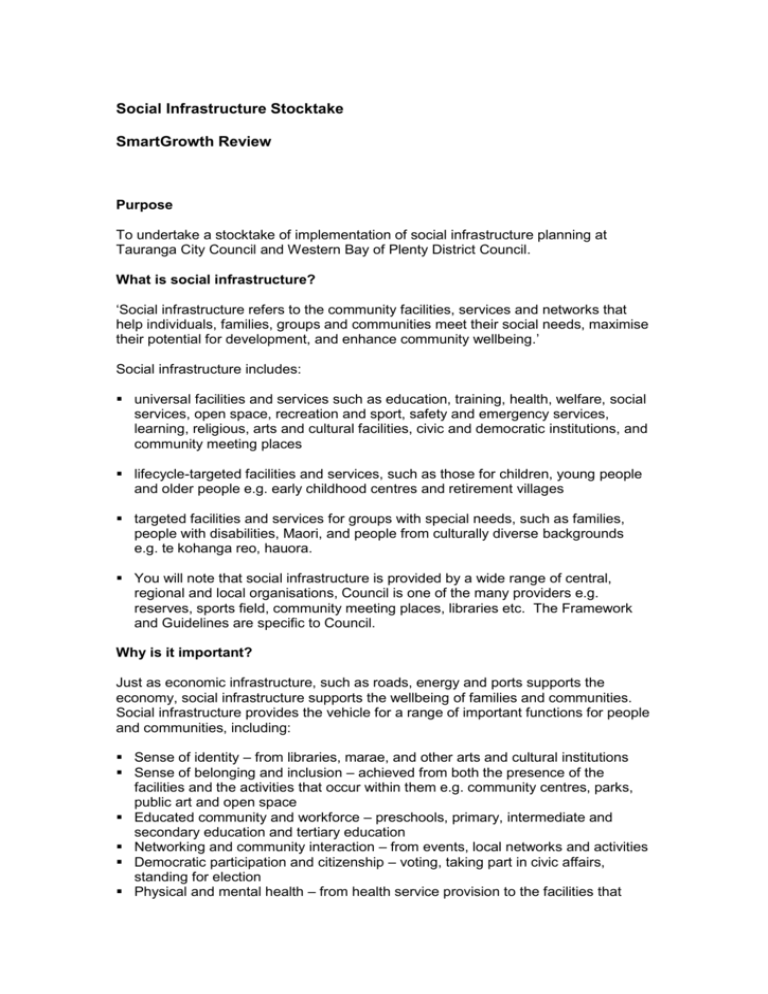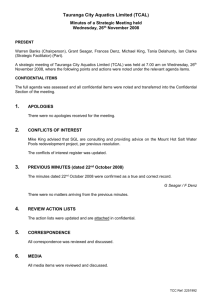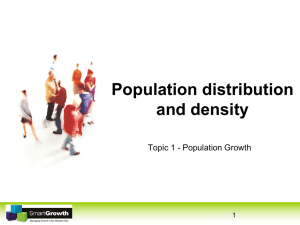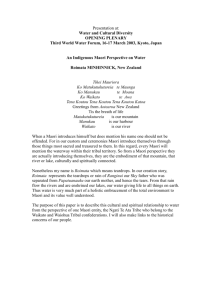Social infrastructure Stocktake
advertisement

Social Infrastructure Stocktake SmartGrowth Review Purpose To undertake a stocktake of implementation of social infrastructure planning at Tauranga City Council and Western Bay of Plenty District Council. What is social infrastructure? ‘Social infrastructure refers to the community facilities, services and networks that help individuals, families, groups and communities meet their social needs, maximise their potential for development, and enhance community wellbeing.’ Social infrastructure includes: universal facilities and services such as education, training, health, welfare, social services, open space, recreation and sport, safety and emergency services, learning, religious, arts and cultural facilities, civic and democratic institutions, and community meeting places lifecycle-targeted facilities and services, such as those for children, young people and older people e.g. early childhood centres and retirement villages targeted facilities and services for groups with special needs, such as families, people with disabilities, Maori, and people from culturally diverse backgrounds e.g. te kohanga reo, hauora. You will note that social infrastructure is provided by a wide range of central, regional and local organisations, Council is one of the many providers e.g. reserves, sports field, community meeting places, libraries etc. The Framework and Guidelines are specific to Council. Why is it important? Just as economic infrastructure, such as roads, energy and ports supports the economy, social infrastructure supports the wellbeing of families and communities. Social infrastructure provides the vehicle for a range of important functions for people and communities, including: Sense of identity – from libraries, marae, and other arts and cultural institutions Sense of belonging and inclusion – achieved from both the presence of the facilities and the activities that occur within them e.g. community centres, parks, public art and open space Educated community and workforce – preschools, primary, intermediate and secondary education and tertiary education Networking and community interaction – from events, local networks and activities Democratic participation and citizenship – voting, taking part in civic affairs, standing for election Physical and mental health – from health service provision to the facilities that encourage physical activity and/or social interaction e.g. reserves, halls, action and community centres Spiritual and cultural wellbeing – from faith based, cultural and spiritual organisations, networks and facilities, such as marae Creative expression – through arts and cultural institutions As noted in the definition, there is social infrastructure developed by and for Maori which is fundamental to Maori wellbeing and reflects Te Ao Maori. These include, but are not limited to, marae, te kohanga reo, kura kaupapa Maori, hauora and wananga. Social infrastructure, both mainstream and Maori specific, contributes to Maori wellbeing, this is discussed in more detail and described in the stock take of Western Bay of Plenty social infrastructure. Framework The Social Infrastructure Planning Framework for the Western Bay of Plenty Subregion was developed in 2009. The document aims to build understanding of what social infrastructure is, why it is important and outline the outcomes, principles and overall purpose for social infrastructure planning. Tauranga City Council and Western Bay of Plenty District Council adopted guidelines for each council to identify how the principles and outcomes of the Framework could be realised. The Framework purpose has been used to guide the stocktake process and determine what has been achieved and where further work is required. Stocktake Framework Purpose Enhance understanding of social infrastructure Progress to Date: WBOPDC Increasing use of the term ‘social infrastructure’ by government, and WBOPDC. Requests by Council staff to incorporate social infrastructure planning in their work. TCC Development of planning guidelines that incorporate SI planning/process considerations Assist the integration of social infrastructure planning into existing Council planning processes Provide information to support social infrastructure planning WBOPDC Social infrastructure planning has been undertaken as part of: The Omokoroa community plan, the Katikati Built Environment and town centre plan Te Puna community plan (in development) Minden structure planning Long Term Plan Communities Strategy Libraries levels of service review. Informing the development of a playground strategy. SmartGrowth Settlement Patterns work. TCC Reserve Management Plan Guidelines developed Place Management approach endorsed Framework Purpose Enhance community involvement in social infrastructure planning Progress to Date: WBOPDC Community members’ views are sought as part of the community planning process and are also expressed via submissions to the community plans. TCC Arataki Community Centre example of community participation in planning for development of community centre both in terms of the community advisory group and the other community engagement approaches used. Support collaborative planning for social infrastructure between Council and other providers of social infrastructure WBOPDC Key social infrastructure providers e.g. schools, medical clinics etc are interviewed to inform the community plan. Information about SmartGrowth, in particular location and timing of growth nodes, has been distributed to key social infrastructure providers e.g. emergency services, police, Ministry of Education, District Health Board etc. Collaboration Bay of Plenty (COBOP), with membership from the regions local and regional authorities and central government departments, has been a useful mechanism to encourage information sharing and working together between local authorities and central government. For example, Central government agencies visited Maketu to learn about their community plan and what role these departments can play in advancing the plan. Membership and input into of a number of interagency groups e.g. SmartGrowth Strategic partners Forum, Population Ageing Technical Advisory Group and Housing Affordability forum, Tauranga Safe City. Social Infrastructure developed since development of guidelines: Huharua Subregional park Planning for an updated skatepark in Katikati Expansion and refurbishment of the Te Puke library Public art installed in Omokoroa (Crapp Reserve and Western Ave Reserve), Te Puke town centre and additional murals in Katikati. Playground in Te Puke - 2012 Pongakawa Indoor Action Centre (commencing construction). New tennis courts Pohutukawa Park, Waihi Beach. Further development of TECT subregional park. TCC Welcome Bay Integrated Plan saw a combined agency approach to development and implementation of the plan which will provide accommodation for the Welcome Bay Community Centre City Centre Action Group Development and implementation of Strand Night Management Plan CoBOP – social wellbeing cluster Tauranga Youth Development Team Tauranga Safe City Framework Purpose Progress to Date: TCC takes a network approach to provision of most types of social infrastructure eg indoor facilities, open space, swimming pools etc. This is generally through development of strategies and the process for this includes identification and consideration of social infrastructure provided by other organisations. See Table 1 and Table 2 of TCC Social Infrastructure Planning Guidelines for new or planned social infrastructure Identified needs included in relevant strategy. General comments Implementation of the Social Infrastructure Framework and Guidelines has been achieved at many levels from strategy development through to project implementation. It has reinforced the importance of taking a collaborative approach to the things that we do both in terms of other organisations and the community. Western Bay of Plenty District Council and Tauranga City Council already have a good track record of doing this through collaborative processes such as establishment of the subregional parks network. The Social Infrastructure Framework and Guidelines have helped to achieve better integration of social infrastructure thinking into councils planning and delivery process. The local benefits, opportunities for Councils to engage with communities, and the ability to provide opportunities for the community to build their capabilities has only seen positive outcomes from the councils experience to date. Perhaps the most useful aspect of the social Infrastructure planning process is that it helps to build a picture of particular communities and their demographics which ensures that the type and location of social infrastructure for areas of our district and city meet the needs of communities, now and in the future. It is beneficial for each Council to have a social infrastructure ‘champion/s’ at a staff level and at a political level although this needs to be balanced with making social infrastructure a part of what all staff do where it applies in their day-to-day work. An area for improvement is further emphasis on the alignment between local government, central government and other providers of social infrastructure. This could occur in many forms. Currently the main form of communication is through the Strategic Partners Forum whose membership includes the District Health Board, Bay of Plenty Polytech and Waikato University partnership and is in the main one of informing and consultation. At a Council level central government (e.g. schools) and Council have co-funded community facilities. Increasingly in Australia a more collaborative approach to social infrastructure planning is occurring. For instance a number of outer Melbourne Councils in growth areas came together with key State government social infrastructure providers to agree on levels of social infrastructure. Other examples include public private partnerships or developer funded social infrastructure. One Council is initiating and basing its infrastructure, residential, commercial and industrial planning on social infrastructure planning. Recommendations for SmartGrowth 1. Continue to acknowledge the role of social infrastructure in our planning and land use processes and the benefits of this e.g. council and local communities working together. 2. The Framework, Guidelines and current good practice continue to be used to undertake social infrastructure planning as part of all other relevant Council planning (e.g. infrastructure network planning, community planning, structure planning). 3. Ensure all partners of the Strategy have adequate resourcing for staff training in social infrastructure planning. 4. Where appropriate, take a subregional approach to the planning and provision of specific types of social infrastructure as currently occurs with subregional parks. 5. SmartGrowth considers to what extent it wishes to work other providers of social infrastructure (e.g. Ministry of Education, District Health Board) to ensure an integrated consistent provision of social infrastructure throughout the sub region. Options: a. Status quo – informing and consulting with other social infrastructure providers; b. Explore opportunities such as public private partnerships in the development of social infrastructure, agreed levels of social infrastructure with other providers and/or increased collaborative social infrastructure planning with other providers. 6. Monitor and consider the role of iwi and hapu social infrastructure and the potential for this to be even greater as an outcome of the treaty settlement process









